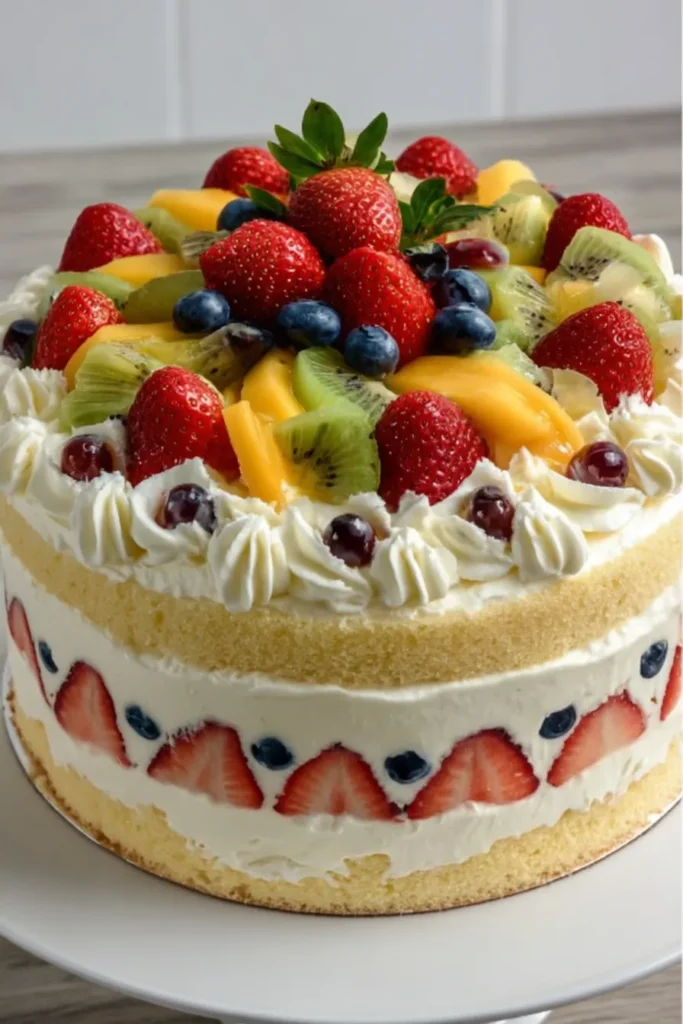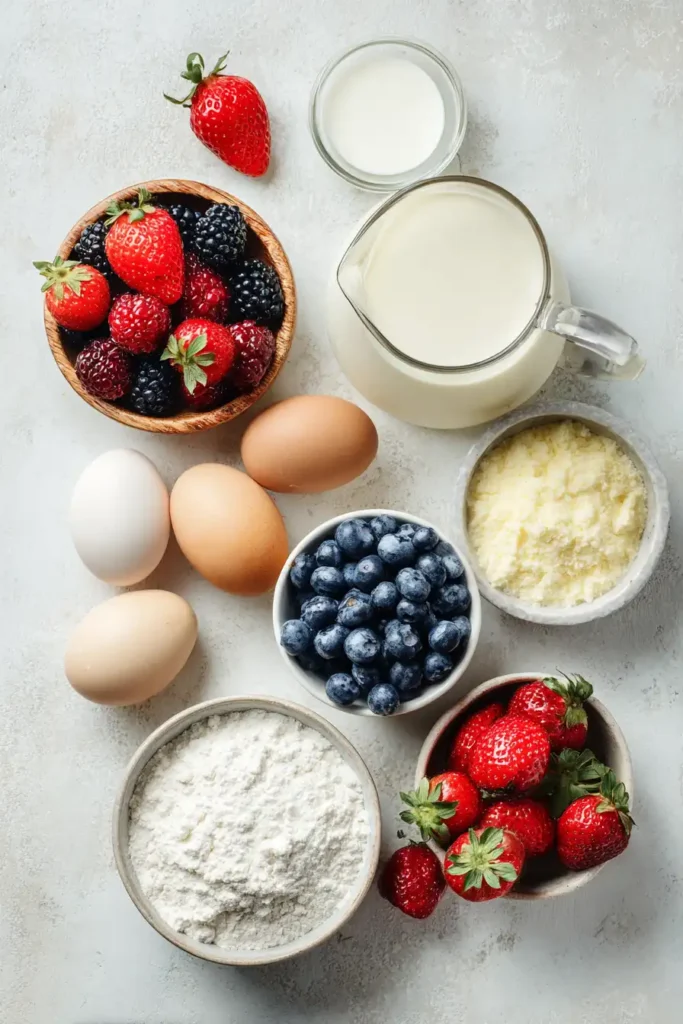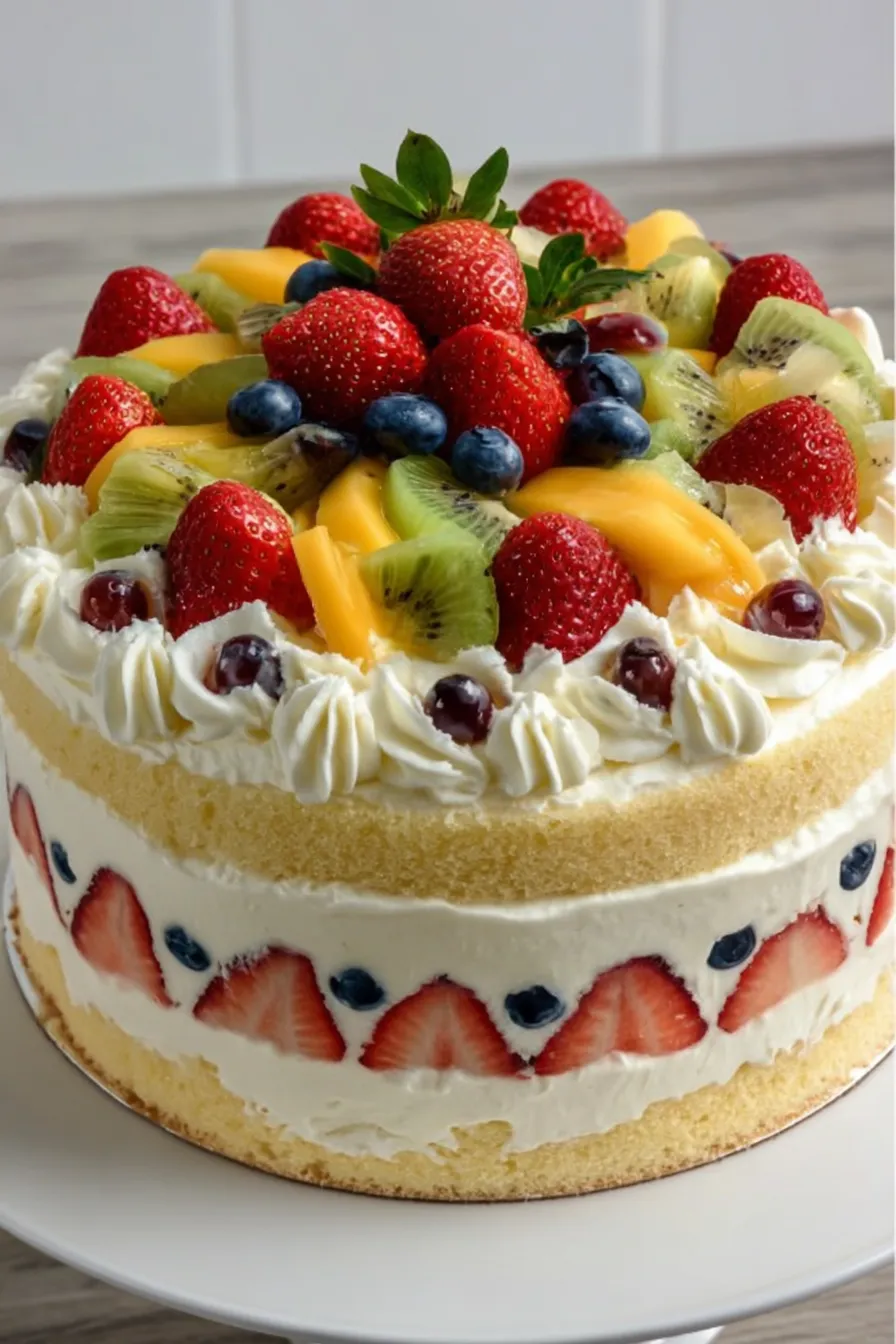Fruit cream cake transformed my understanding of what dessert could be during one unforgettable summer afternoon at my aunt’s countryside home. While watching her create magic with nothing more than fresh strawberries from her garden, fluffy whipped cream, and a simple sponge cake, I discovered that sometimes the most beautiful desserts come from the simplest combinations. That day sparked my lifelong love affair with fresh fruit cream cakes, and now I’m excited to share this journey with you. This recipe brings together seasonal fruits, airy sponge cake, and perfectly whipped cream to create a dessert that’s both elegant enough for special occasions and simple enough for weekend treats.

Table of Contents
Fruit Cream Cake Perfection Made Simple
Why Fresh Fruit Cream Cakes Win Every Time
Fresh fruit cream cake stands apart from other desserts because it celebrates the natural sweetness and vibrant colors of seasonal produce. Unlike heavy, overly sweet cakes that can leave you feeling sluggish, this delightful creation offers a perfect balance of textures and flavors that actually makes you feel good after eating it.
The beauty of fruit cream cake lies in its versatility. During spring, you can showcase delicate strawberries and kiwi slices. Summer brings an abundance of berries, peaches, and plums that make your cake look like a work of art. Even autumn pears and winter citrus fruits can transform this basic recipe into something spectacular.
What really sets this dessert apart is how it lets each component shine. The light sponge cake provides structure without overwhelming the palate, while the whipped cream acts as a perfect canvas for your chosen fruits. Together, they create a harmony that’s both satisfying and refreshing.
Additionally, this approach to cake-making shares techniques with our Italian cream cake, where layers and cream work together to create something truly special.
The Secret to Moist Sponge and Perfect Cream Balance
Creating the perfect fruit cream cake requires understanding the relationship between your sponge base and cream layers. The sponge needs enough structure to support multiple layers while remaining tender enough to cut cleanly with a fork. Meanwhile, your whipped cream should be stable enough to hold its shape but light enough to complement rather than compete with your fruits.
Temperature control plays a crucial role in achieving this balance. Your sponge should be completely cool before assembly, preventing the cream from melting and creating soggy layers. The cream itself should be whipped to soft peaks initially, then finished to medium peaks just before assembly.
Professional bakers often add a touch of cornstarch to their whipped cream for extra stability, especially important when working with juicy fruits that might release moisture over time. This small addition can mean the difference between a cake that looks beautiful for hours versus one that starts to weep within minutes of assembly.
The fruit selection and preparation also impacts your final result significantly. Properly dried fruits prevent excess moisture from compromising your cake’s structure, while strategically placed fruit pieces can actually help absorb any minor moisture without affecting taste or appearance. Furthermore, these techniques also apply to other layered desserts like our blackberry cheesecake, where moisture management is equally crucial.
Essential Ingredients for Your Dream Fruit Cream Cake
Fresh Seasonal Fruits That Work Best
Selecting the right fruits can make or break your fresh fruit cream cake experience. However, you don’t need exotic ingredients to create something extraordinary. Most successful fruit cream cakes rely on fruits that balance sweetness, acidity, and visual appeal while maintaining their structure when layered with cream.
Berries consistently deliver the best results because they hold their shape beautifully and provide bursts of concentrated flavor. Strawberries work particularly well when sliced into uniform pieces, while blueberries and raspberries can be used whole for textural contrast. Moreover, these techniques work brilliantly with other berry-based desserts in our kitchen repertoire.
| Fruit Type | Best Season | Preparation Method | Layer Position |
|---|---|---|---|
| Strawberries | Spring-Summer | Hull and slice 1/4 inch thick | Middle and top layers |
| Blueberries | Summer | Rinse and pat dry completely | All layers for color contrast |
| Raspberries | Summer-Fall | Use whole, handle gently | Top layer for garnish |
| Kiwi | Year-round | Peel and slice into rounds | Middle layers for tartness |
| Peaches | Summer | Peel and slice thinly | Middle layers primarily |
Stone fruits like peaches and plums bring incredible sweetness and beautiful colors to your cake, though they require careful handling to prevent excess juice from making your layers soggy. Furthermore, citrus segments can add brightness, but you’ll want to remove all membranes and pat them dry thoroughly before use.
Cream and Sponge Foundation Ingredients
The foundation of any exceptional fruit cream cake starts with quality ingredients that work harmoniously together. Moreover, understanding how each component contributes to the final texture helps you make smart substitutions when needed, similar to the approach we use in our gooey coconut cake.
For the sponge cake base, you’ll need these essential ingredients that create the perfect tender crumb:
- All-purpose flour (2 cups): Provides structure without making the cake heavy
- Large eggs (4 whole): Creates lift and binding power for optimal texture
- Granulated sugar (1 cup): Sweetens and helps create the light, airy structure
- Unsalted butter (1/2 cup, melted): Adds richness and keeps the cake moist
- Whole milk (1/2 cup): Provides moisture and helps create tender crumb
- Baking powder (2 teaspoons): Essential leavening agent for proper rise
- Pure vanilla extract (1 teaspoon): Adds depth and complements fruit flavors
- Salt (1/4 teaspoon): Balances sweetness and strengthens gluten structure
The whipped cream component requires equally careful ingredient selection. Consequently, using the right cream and stabilizers ensures your fruit cream cake maintains its beautiful appearance for hours after assembly.
- Heavy whipping cream (2 cups, 35% fat minimum): Creates stable, fluffy peaks that hold their shape
- Powdered sugar (1/2 cup): Sweetens without grittiness and adds stability
- Cornstarch (1 tablespoon): Prevents weeping and maintains cream structure
- Vanilla extract (1 teaspoon): Complements both fruit and cake flavors beautifully

Professional bakers often recommend chilling your mixing bowl and beaters for at least 15 minutes before whipping cream. This simple step significantly improves your chances of achieving perfect peaks quickly without over-whipping. Similarly, room temperature eggs whip up much faster and create better volume in your sponge cake, so plan ahead by taking them out about an hour before baking.
Quality ingredients make a noticeable difference in your final result, especially when working with simple recipes like this where each component plays a starring role. Therefore, investing in good vanilla extract and using fresh, properly stored cream will reward you with superior flavor and texture that rivals any bakery creation. For additional layering techniques, our Boston cream pie cheesecake offers excellent insights into working with cream-based desserts.
How to Make Fruit Cream Cake Step by Step
Preparing the Perfect Sponge Base
Creating your fruit cream cake begins with mastering the sponge foundation. Start by preheating your oven to 350°F (175°C) and greasing two 8-inch round cake pans with butter, then dust lightly with flour to prevent sticking.
Begin by separating your room temperature eggs, placing whites in one clean bowl and yolks in another. This separation technique creates the light, airy texture that makes fruit cream cake so special. Beat the egg whites until soft peaks form, then gradually add half the sugar while continuing to beat until stiff, glossy peaks develop.
In your second bowl, whisk together egg yolks with the remaining sugar until the mixture becomes pale and thick, approximately 3-4 minutes. Slowly drizzle in melted butter while whisking constantly, then add vanilla extract and milk. Furthermore, this gentle incorporation prevents the mixture from curdling.
Sift flour, baking powder, and salt together in a separate bowl, then gently fold this mixture into the yolk combination using a rubber spatula. Work quickly but carefully to maintain the light texture. Next, fold one-third of the beaten egg whites into the batter to lighten it, then gently fold in the remaining whites in two additions.
Divide batter evenly between prepared pans and bake for 22-25 minutes, or until a toothpick inserted in the center comes out clean. Allow cakes to cool in pans for 10 minutes before turning out onto wire racks to cool completely. This cooling process prevents your cream from melting during assembly, just like the techniques we use in our brownie cheesecake for optimal layering.
Assembling Your Fresh Fruit Layers
Assembly transforms your individual components into a stunning fruit cream cake masterpiece. Begin by preparing your stabilized whipped cream, which requires chilling your bowl and beaters in the freezer for 15 minutes beforehand.
Pour cold heavy cream into the chilled bowl and whip on medium speed until it begins to thicken. Gradually increase speed while slowly adding powdered sugar and cornstarch, which acts as a natural stabilizer. Continue whipping until medium peaks form – they should hold their shape but not appear grainy or over-beaten.
Cut each cooled sponge layer horizontally in half using a long serrated knife, creating four thin layers total. This technique increases the fruit-to-cake ratio and creates more impressive visual layers when sliced.
| Assembly Step | Layer Component | Amount Needed | Pro Tip |
|---|---|---|---|
| 1. Base Layer | Sponge + Cream + Fruit | 1/4 of each component | Start with least attractive cake layer on bottom |
| 2. Middle Layers | Repeat pattern twice | 1/4 of each component x2 | Press gently to eliminate air pockets |
| 3. Top Layer | Cake + decorative cream | Remaining components | Save prettiest fruits for final garnish |
Place your first sponge layer on your serving plate and spread approximately one-fourth of the whipped cream evenly across the surface. Arrange your prepared fruits in a single layer, leaving small gaps for cream to settle between pieces. Repeat this process with each layer, taking care to align edges for a professional appearance.
For the final layer, spread remaining cream smoothly over the top and sides of the cake using an offset spatula. Create decorative swirls or keep it simple with a smooth finish, depending on your preference. Finally, arrange your most beautiful fruit pieces on top, creating an artful pattern that showcases the seasonal bounty.
Chill your completed fruit cream cake for at least 2 hours before serving, allowing flavors to meld and the structure to set properly. This resting period also makes slicing much easier and cleaner. The assembly techniques here work beautifully for other layered desserts too, including our popular Oreo dirt cake that uses similar layering principles.
Serving and Storage Tips for Maximum Enjoyment
Best Presentation Techniques
Presenting your fruit cream cake beautifully transforms a homemade dessert into a restaurant-quality centerpiece. Start by using a sharp, thin-bladed knife dipped in warm water between each cut to create clean, professional slices without crushing the delicate layers.
For special occasions, consider garnishing each plate with a light dusting of powdered sugar or a drizzle of berry coulis made from pureed fresh fruit. Additionally, placing a few mint leaves or edible flowers alongside each slice adds an elegant touch that photographs beautifully for social media.
When serving larger groups, pre-cutting the cake and arranging slices on individual plates prevents the dessert from becoming messy during service. This approach works particularly well when you want to showcase the beautiful interior layers that make fruit cream cake so visually appealing.
Temperature matters significantly for optimal taste and texture. Serve your fruit cream cake slightly chilled, removing it from the refrigerator about 10-15 minutes before cutting to allow the flavors to brighten while maintaining the cream’s structure. This timing creates the perfect balance between refreshing coolness and full flavor development.
Consider pairing your fruit cream cake with complementary desserts for a complete spread. Our small apple pie makes an excellent companion for fall gatherings, while lighter fruit-based treats work beautifully together.
Keeping Your Cake Fresh and Delicious
Proper storage extends your fruit cream cake’s life while maintaining its perfect texture and flavor. Cover the cake loosely with plastic wrap or store under a cake dome in the refrigerator, where it will stay fresh for up to three days.
Avoid storing your cake in airtight containers, as trapped moisture can make the sponge layers soggy and cause the cream to weep. Instead, allow some air circulation while protecting the surface from drying out or absorbing refrigerator odors.
For longer storage, you can freeze individual slices wrapped in plastic wrap and aluminum foil for up to one month. Thaw frozen pieces in the refrigerator overnight, and they’ll taste nearly as fresh as the day you made them. However, avoid freezing the complete assembled cake, as the texture changes significantly during the thawing process.
Plan your assembly timing carefully if making this cake for an event. While the individual components can be prepared a day ahead, assemble the final cake no more than 6-8 hours before serving to prevent the fruit juices from breaking down the cream structure.
Leftover fruit from your cake preparation doesn’t have to go to waste. Transform extra berries into our delightful strawberry crinkle cookies for a perfect dessert pairing or afternoon treat.
FAQ
What are the 5 main ingredients in cake?
The five essential ingredients in most cakes are flour (provides structure), eggs (bind and leaven), sugar (sweetens and tenderizes), fat like butter (adds moisture and richness), and a leavening agent such as baking powder (creates rise and lightness). These core components work together to create the perfect cake texture and flavor foundation.
What is fruit cake also known as?
Traditional fruit cake is often called “Christmas cake” or “holiday cake” in many cultures, particularly when made with dried fruits, nuts, and spirits. However, fresh fruit cream cake like our recipe represents a lighter, more modern interpretation that’s sometimes called “fresh fruit gateau” or simply “berry cream cake” depending on the fruits used.

Fruit Cream Cake
Equipment
- 8-inch round cake pans (2)
- Electric mixer
- Wire cooling racks
- Offset spatula
Ingredients
Sponge Cake
- 2 cups all-purpose flour
- 4 large eggs room temperature
- 1 cup granulated sugar
- 1/2 cup unsalted butter melted
- 1/2 cup whole milk
- 2 teaspoons baking powder
- 1 teaspoon vanilla extract pure
- 1/4 teaspoon salt
Whipped Cream & Toppings
- 2 cups heavy whipping cream 35% fat minimum
- 1/2 cup powdered sugar
- 1 tablespoon cornstarch
- 1 teaspoon vanilla extract
- 2 cups mixed fresh berries strawberries, blueberries, raspberries
- 1 large kiwi peeled and sliced
Instructions
- Preheat oven to 350°F (175°C). Grease two 8-inch round pans with butter and dust with flour.
- Separate eggs, placing whites in one clean bowl and yolks in another. Beat egg whites until soft peaks form, then gradually add half the sugar until stiff peaks develop.
- In second bowl, whisk egg yolks with remaining sugar until pale and thick, about 3-4 minutes. Slowly drizzle in melted butter while whisking, then add vanilla and milk.
- Sift flour, baking powder, and salt together. Gently fold into yolk mixture. Fold one-third of beaten whites into batter, then fold in remaining whites in two additions.
- Divide batter between prepared pans and bake 22-25 minutes until toothpick comes out clean. Cool in pans 10 minutes, then turn onto wire racks to cool completely.
- For whipped cream, chill bowl and beaters 15 minutes. Whip cold cream on medium speed, gradually adding powdered sugar and cornstarch until medium peaks form.
- Cut each cooled cake layer horizontally in half with serrated knife, creating four thin layers total.
- Place first layer on serving plate. Spread 1/4 of whipped cream evenly, then arrange prepared fruits in single layer. Repeat with remaining layers.
- Spread remaining cream over top and sides. Arrange most beautiful fruits on top for decoration.
- Chill completed cake for at least 2 hours before serving to allow flavors to meld and structure to set.
More Dessert Recipes
Explore these related dessert recipes to expand your baking repertoire:

